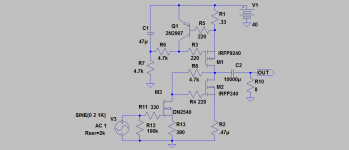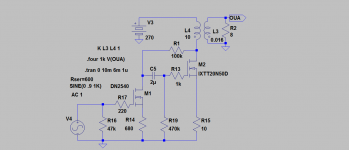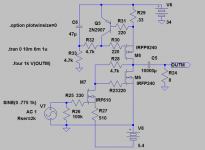Hey Nelson,
We have earlier discussed the similarity of Zen to the Schade(1937) tube circuit. I have also put my thinking cap on a lot find a solution. From an idea from Michael Koster I have adopted the Zen to the tubecircuit. Shows really good performence rel. Zen when simmed.
Note this only an idea, no guarantee it will work IRL with MOSFETs.
Output voltage is adjusted with the drivers source-resistor. Ie two matched drivers must be used for equal gain.
We have earlier discussed the similarity of Zen to the Schade(1937) tube circuit. I have also put my thinking cap on a lot find a solution. From an idea from Michael Koster I have adopted the Zen to the tubecircuit. Shows really good performence rel. Zen when simmed.
Note this only an idea, no guarantee it will work IRL with MOSFETs.
Output voltage is adjusted with the drivers source-resistor. Ie two matched drivers must be used for equal gain.
Attachments
Mistake in the schematic:
Remove lower .47ohm, doesn´t alter performance though.
Also sims indicate below 0.1% THD at 1W. Don´t take this for granted though as sims in LTSpice aren´t 100% reliable.
Michaels tube solution:
http://www.diyaudio.com/forums/tubes-valves/165221-most-linear-triode-strapped-pentode-16.html#post2210904
Remove lower .47ohm, doesn´t alter performance though.
Also sims indicate below 0.1% THD at 1W. Don´t take this for granted though as sims in LTSpice aren´t 100% reliable.
Michaels tube solution:
http://www.diyaudio.com/forums/tubes-valves/165221-most-linear-triode-strapped-pentode-16.html#post2210904
Last edited:
If we can trust the sims, damping factor should be in the ballpark of 50! -6dBU 8 ohms rel 0,16ohms, makes me wonder.....
Check out the "SiC Puppy" in this same forum - it's basically an RH-84 type amp with silicon/SiC instead of vacuum devices. I may try somethink like you're doing at lower voltage. The Puppy runs at 300V.
Zen is a beauty in its simplicity. This one is a way of adding gain and high inputZ and also remove the input coupling cap. Adding a FET and losing components.
Sorry, I don´t find your solution to my liking. Overcomplicated, global feedback, two couplingcaps etc.
Can not, thankfully, see RH84 in yours this one, use a triode(not so funny) input. A MOSFET is actually like a pentode in performance. So yours is more Schade in that case. But feedback over two stages and OPT is what you should avoid when doing it right.
I suggest you check MJKs innovative solution again.
KISS= Keep It Simple, Stupid(not you)😉.
Sorry, I don´t find your solution to my liking. Overcomplicated, global feedback, two couplingcaps etc.
Can not, thankfully, see RH84 in yours this one, use a triode(not so funny) input. A MOSFET is actually like a pentode in performance. So yours is more Schade in that case. But feedback over two stages and OPT is what you should avoid when doing it right.
I suggest you check MJKs innovative solution again.
KISS= Keep It Simple, Stupid(not you)😉.
Last edited:
Show me a solution that uses 300V with no coupling cap and no output transformer - you have a coupling cap on the output, after all. The real puspose of this design was to take a tube-type schematic and sub semiconductors. The equivalent tube amplifier would have used 2 pentodes, as you say. Sooner or later, I'll build the tube equivalent as a comparison, coupling caps, output transformer, and all. BTW, 2 active devices is not exactly what I would call complex. The 3rd device is a capacitance multiplier that will be used when I'm powering the amp from a 60Hz transformer rather than a bench supply. The stopper resistors and gate protection zeners are real-world necessities.
An input cap is a necessity, as you cannot tell which piece of equipment will be delivering a DC offset to your system, or will decide to break and do it. Fortunately, a DC input would not blow up this amp or cook the speakers, but it would saturate the input stage. I have a high end CD player has an output DC offset. Sounds very nice, otherwise.
The global feedback is not very much, and tightens up the frequency response considerably, as can be seen from the square wave response pictures. I don't consider global feedback to be the devil incarnate, anyway. It would be interesting to remove the partial feedback resistor and see if there is an audible difference. I may adjust the ratio of partial to global feedback in the design later on, but I just got the whole thing up and delivering tunes just yesterday.
An input cap is a necessity, as you cannot tell which piece of equipment will be delivering a DC offset to your system, or will decide to break and do it. Fortunately, a DC input would not blow up this amp or cook the speakers, but it would saturate the input stage. I have a high end CD player has an output DC offset. Sounds very nice, otherwise.
The global feedback is not very much, and tightens up the frequency response considerably, as can be seen from the square wave response pictures. I don't consider global feedback to be the devil incarnate, anyway. It would be interesting to remove the partial feedback resistor and see if there is an audible difference. I may adjust the ratio of partial to global feedback in the design later on, but I just got the whole thing up and delivering tunes just yesterday.
BTW, I'd worry a bit about not having a whole lot of voltage across your input fet - unless I miss my guess, there wil only be 4-5 volts across it. A coupling cap would help, but you don't like them...
Anyway my design will be the simplest way to correct the shortcomings, low Zin and sensitivity) of the original Zen for those who needs it..
No problems with ca 5V, we have tested the driver IRL and it works like a charm. The driver works in I/V mode and the low output needed is good enough with margin. Scale gain and needed ouput voltage from a typical 300V amp tube amp.
High voltage without coupling caps and global NFB is no problem at all. Apparently you didn´t read my link about MJKs solution, check again😉. To get rid of the OPT isn´t possible though. BUt why use 300V? Only makes things complicated with sand. With low voltage we do it the NP way and I think it works......
Use MJKs modell, but AC and FET out, instead, nice and clean. Will work much better IRL than the input stage you use. We have tested that IRL. So go away and loose a bunch of components.
Why not correct a fault where it is? Correct the CD with an output capacitor instead of in the amp. If you only use CD, correct the driverstage to have its working point with the offset applied.
I promise, will not the discuss your Sic amp anymore.
No problems with ca 5V, we have tested the driver IRL and it works like a charm. The driver works in I/V mode and the low output needed is good enough with margin. Scale gain and needed ouput voltage from a typical 300V amp tube amp.
High voltage without coupling caps and global NFB is no problem at all. Apparently you didn´t read my link about MJKs solution, check again😉. To get rid of the OPT isn´t possible though. BUt why use 300V? Only makes things complicated with sand. With low voltage we do it the NP way and I think it works......
Use MJKs modell, but AC and FET out, instead, nice and clean. Will work much better IRL than the input stage you use. We have tested that IRL. So go away and loose a bunch of components.
Why not correct a fault where it is? Correct the CD with an output capacitor instead of in the amp. If you only use CD, correct the driverstage to have its working point with the offset applied.
I promise, will not the discuss your Sic amp anymore.
Attachments
Last edited:
Had to take another look at original vs. the two stage version. Distortionfigures made me suspicious.
The sims indicate the Zen revisited and the Zen/Schade has the same overtone structure and levels. The exception is that the Zen/Schade has higher 2nd tone, making it higher than the 3rd(same for both).
Gain 8-9dB higher. Zin going from 1kohm to 100kohm.
The sims indicate the Zen revisited and the Zen/Schade has the same overtone structure and levels. The exception is that the Zen/Schade has higher 2nd tone, making it higher than the 3rd(same for both).
Gain 8-9dB higher. Zin going from 1kohm to 100kohm.
- Status
- Not open for further replies.
- Home
- Amplifiers
- Pass Labs
- Zen with DC Schade driver


